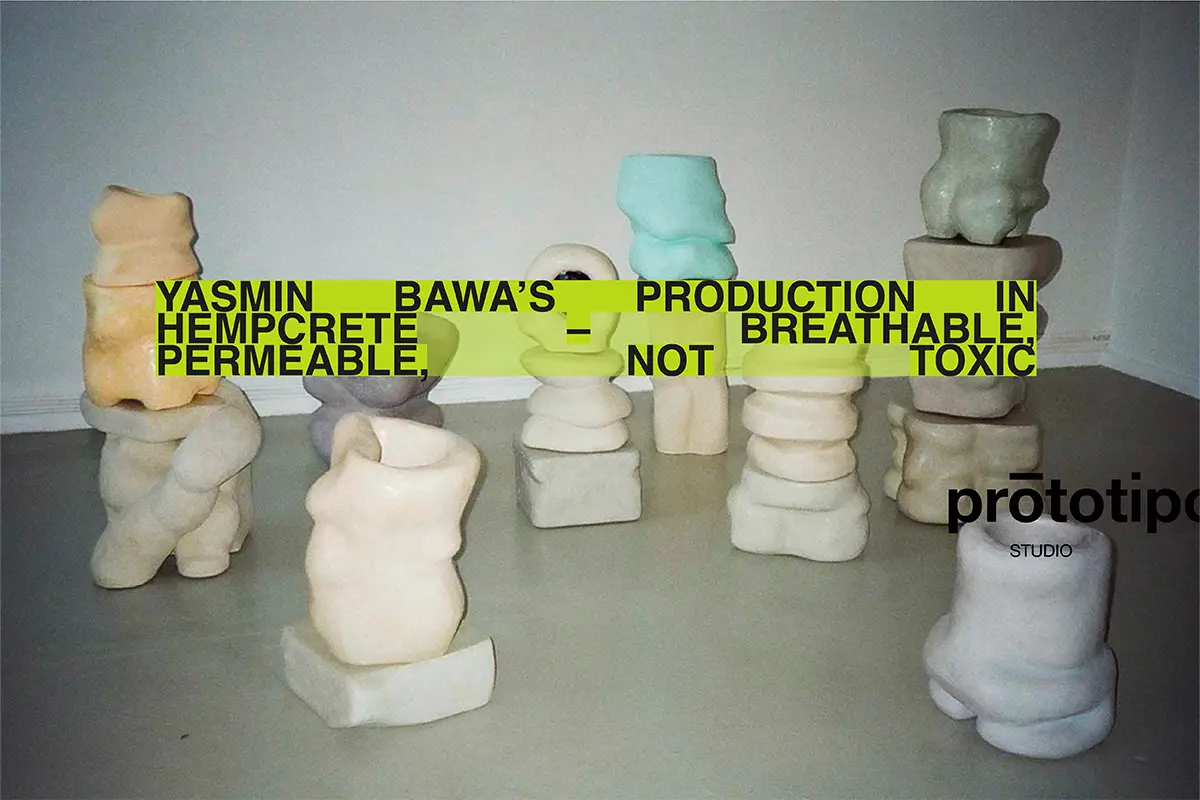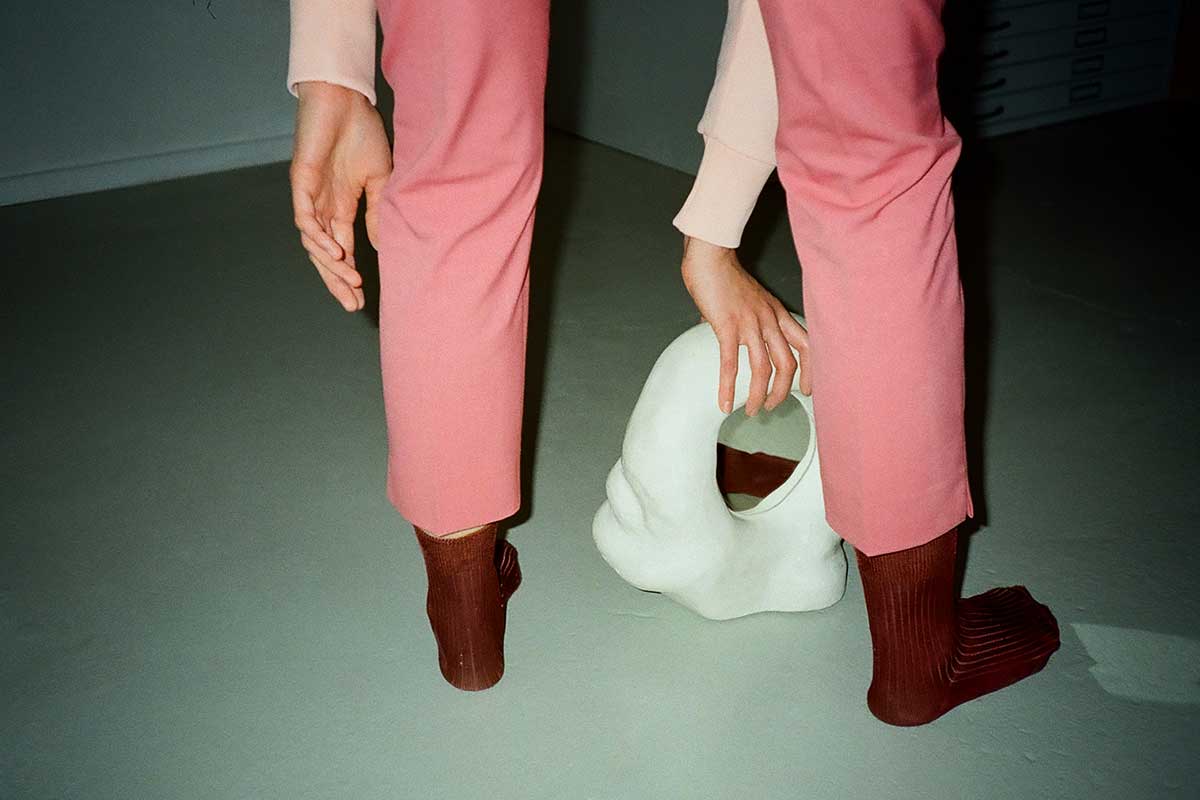«When I abandoned concrete, I managed to find something that is the opposite: it is breathable, permeable, not toxic». Yasmin Bawa’s production from concrete to hempcrate
Lampoon introduces Yasmin Bawa
Yasmin Bawa is a Berlin based object and furniture designer whose work is based on an exploration of materials and techniques which lead to the creation of multiform sculptures. With a background in textile design and having worked for Swedish brand Acne Studio as an accessory designer, Bawa found hard to understand the rhythm of fashion production and after three years there she left her job and started working freelance: «In the fashion world I used to work so fast that I did not have time to really focus on the design, and after a while I felt the need to change my way of work and start to nurture my design ideas longer and with more care. The environmental issues relating to the fashion world and its production process influenced my decision as well». During that period, she realized that her production was undergoing an evolution and the design pieces she was creating were turning into sculptures. Even though she claimed that her entry into the art world was not marked by big art galleries exhibitions or events, she understood that her new artistic creations and her desire to build and mold things with her own hands required a new approach. Her work is the result of research and readings that encompass different disciplines such as archeology, architecture and poetry which stem from her own interests and curiosity, but also serve as inspirations for her sculptures. Her search for different sustainable and natural materials to use in her work is central to her approach as it was what first draw her away from the fashion world and into the art one.
Hempcrate in design
When making the transition from accessory to sculpture design, Bawa started working with a particular kind of moldable concrete which could be combined with good results with different types of additives. She soon realized however, that the objects she was creating implied high costs in terms of contamination and toxicity for the environment and her own health. Concrete required the use of sealers and chemical resins equally toxic and unhealthy. «It was a personal decision. I asked myself: should I work with concrete, which is a very unfriendly environmental material? Do I want to put my stuff on concrete and live and breathe around it? ». While researching natural building methods, Bawa found out about a house built out of hempcrete, a mixture of hemp shiv, clay and lime binders. Hempcrete is a growing industry for the construction of sustainable and ecological houses acting as insulator and moisture regulator. Industrial hemp, which is beneficial for the soil and does not require the use of pesticides and other chemicals, is able to capture carbon dioxide and bind it permanently to the materials and elements used to create hempcrete objects. Bawa believed the material could be the solution to her sustainability problem and decided to scale the use of hempcrete down to the furniture design sector. «When I abandoned concrete, I managed to find something that is the opposite: it is breathable, permeable, not toxic».
Yasmin Bawa’s Species of the space
The experimental and research stage lasted a few months, but after she got an understanding of the properties and characteristics of hemp, Bawa started to play with it, combining hemp fibers with materials and different types of lime binders. The result was her ongoing series of sculptures Species of the space. Once the sculpture is dry and its shape defined, Bawa overlays the surface with a plaster, often mixed with natural pigments and colors. «My technique is constantly evolving as I keep trying new materials: there are hundreds of different types of lime binders and ratios, and it changes with the weather as well. I do not have written down recipes, it is intuitive because I know now its rules and peculiarities. Sometimes I try a new recipe and if I see that it is not working as I wanted to, I change it». Despite its strength and multiple properties, hempcrete is not a structural material and it often requires a support material or concrete foundations, when used for architectural purposes.
In Bawa’s works, it translates into the use of internal structures or technical substrates for the construction of large objects adding projecting elements to her sculptures. «I am aware that the most sustainable thing would be to not make anything, thus I try to create objects and sculptures which people can and might want to keep for a long time and not just pieces of furniture which people put in a corner and forget about» Bawa said. Her goal is to design and create long-lasting objects which encourage a relationship with the space and the user, who can play with the item, rotating or moving it around and appreciating it from different perspectives: «In my Species of the space each piece can be moved, rotated and put in dialogue with others and soft narratives can arise around them». Even the promotional pictures, shot by her creative partner and photographer, Margaret Flatley, inside the studio, aim to show potential buyers the many different faces of the sculptures and the multiple ways of interacting with them, encouraging the users to establish a relationship with the objects.
The thaumaturgic power of art
The artistic production of Bawa is constantly evolving. She tries new polishing materials, limes and clays and her experiments make each piece unique and different. She’s currently experimenting with two different materials: the first one being a Japanese natural blue clay which she combines with other pigments and colors to give her pieces a distinctive look; the second is a sort of powder which derives from the extraction of CBD from hemp plants. It is a quality organic material which gives green pigments and littles speckles to her creations. Her interest towards organic waste materials is not confined to the CBD powder, it ranges from a Mediterranean seaweed discovered by Bawa in southern France a year ago, to scrap elements from previous works in a sort of circular economy in which nothing goes to waste, but instead it can be reused for artistic purposes.
Bawa’s last series of sculptures is the fruit of almost four months of work which resulted in the production of pastel-colored vessels and sculptures with round and soft lines. «During the months of lockdown, my work was the only thing which kept me going » Bawa claimed. Her works, which can be subdivided in vessels, blocks, objects of various kinds and lighting pieces, draw inspiration from the relationship between individuals and the surrounding environment. Being able to create and shape things with her own hands has provided Bawa with the opportunity to connect her body and her inner consciousness. Two pieces produced in those times, Jui Vessel and Santu Block, have been displayed at Heal your body, an art exhibition organized by Original Feelings studio in Berlin and dedicated to female artists and the way they try to heal their bodies and souls through the thaumaturgic power of art and creativity. The production of furniture and design objects, sometimes small and handy, sometimes monolithic, does not seem to be enough for Bawa. Her ultimate goal is to build an entire house out of hemp in the southern France countryside enjoying the warm weather.
Yasmin Bawa designer
Yasmin Bawa is a designer of objects, furniture and spaces. Her work focuses on the research and exploration of hempcrete, a natural mixture of hemp, limes and clay, which is becoming common for the construction of ecological and sustainable houses. Her intuition was to use hempcrete for the production of small-scale design objects which create the series of sculptures called Species of the space. Her works aim at encouraging long-lasting relationships between objects and users and raise awareness around conscious consumption and the beneficial properties of hemp and other organic materials. Berlin-based, Bawa studied textile design in London and worked as accessories designer for Swedish fashion brand Acne Studios before quitting her job to become a designer.




















